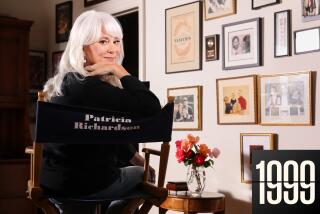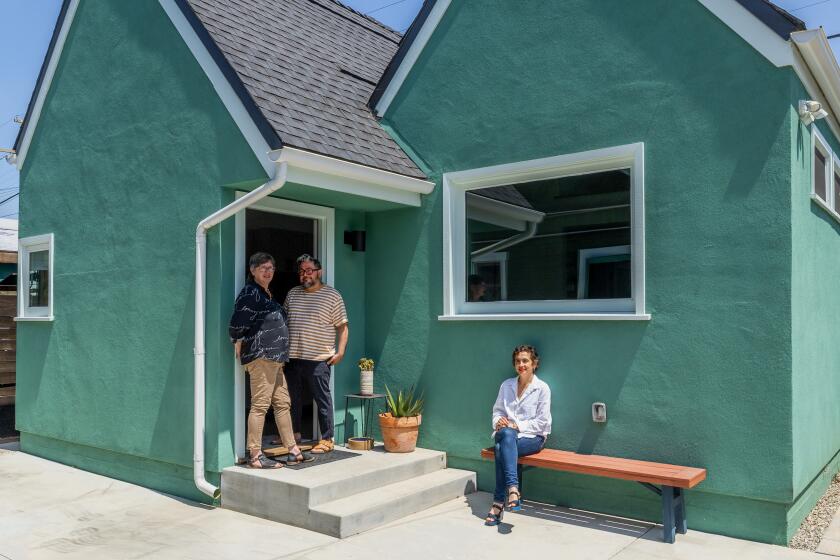Old Firm Keeps Young Remolding Past : Theaters and Hotels Among Its Major Restoration Projects
Silent screen star Clara Bow’s “It Cafe” in Hollywood is gone but not forgotten, thanks to an old sketch kept in a fireproof vault.
The vault is in the studio of A.T. Heinsbergen & Co., which also harbors hundreds of other sketches and photographs of beautiful, ornate interiors that have been destroyed through the years--interiors that might have been restored because the firm that originally created them is still around.
After 63 years, the firm, now bearing the name of the founder’s son, is still “alive and well and in business,” as Dawn Heinsbergen, vice president of the Los Angeles company, phrases it.
It is still in the castle-like building that its founder, Anthony B. Heinsbergen, had built on Beverly Boulevard in 1927 from the bricks of the old Los Angeles City Hall.
And it is still working on some of the fanciest buildings in town.
In New York, it’s part of a team refurbishing Carnegie Hall.
In San Diego, it’s helping to renovate the 1920s building used by the San Diego Symphony.
And in Los Angeles, it’s painting the lobby ceiling of the half-century-old Pershing Square Building, and it’s restoring the lobby it designed more than 50 years ago at One Bunker Hill. It’s also restoring ceilings it painted nearly 58 years ago at the Hollywood Roosevelt Hotel and wall and ceiling decorations it created 44 years ago at the Wiltern Theatre, which will reopen on Wednesday after being closed for five years.
“When Tony’s dad (Anthony B. Heinsbergen) was around, the firm did the interiors of 757 theaters, but only about 200 of them are left,” Dawn Heinsbergen said. She was married to Anthony T. Heinsbergen for 15 years and has been divorced from him for the past eight. He is the firm’s president, chief executive officer and treasurer.
Anthony B. Heinsbergen died in 1982. He was born in Holland and came to Los Angeles in 1907. He started out as an apprentice in a local interior decoration firm but soon joined another firm working on a building in Seattle. While there, the owner of the firm died, leaving Heinsbergen, then 20, with the business and 22 major jobs from coast to coast. He also did work in Canada and Mexico.
“He had a crew of 185 artist painters and when they were not working on a specific job, they made tapestries,” Dawn Heinsbergen said.
On the jobs, they painted spectacular ceilings and wall decorations. A.B. Heinsbergen was one of the finest muralists in the United States.
Examples of the firm’s early work can be seen at the Pantages Theatre in Hollywood, the U .S. Department of Commerce Building in Washington, the Los Angeles and Beverly Hills city halls, Sir Francis Drake Hotel in San Francisco and Biltmore Hotel in downtown Los Angeles.
Dawn Heinsbergen smiled. “We’re doing samples for the Biltmore.”
Recently purchased, the Biltmore probably will be re-oriented to face Grand Avenue instead of Pershing Square, she explained, “and there will be a porte-cochere and extensive remodeling but with all of the old architecture and decor to be restored.”
The Heinsbergen firm is now restoring much of the interior decoration it created years back. “To do work over is wonderful,” Dawn Heinsbergen said. “It’s a marvelous visual statement of what the firm has done, is doing and what it can do in the future.”
Sure, it’s still taking on new design work. With a staff of about 28 people, it has--by A. T. Heinsbergen’s estimate--40 jobs in progress. Among these are projects for several banks, an S&L; headquarters, a country club, a restaurant and a sorority at UCLA.
Unlike the old days, the firm now coordinates carpeting, drapery and furnishings as well as fashioning all kinds of artwork--not just wall and ceiling decoration--to complement the decor. In addition, the company is involved in space planning. But it’s the firm’s interest in the past, whether it was a job first done by it or another company, that gives Dawn Heinsbergen the most satisfaction and concern.
“I’m pleased to say that we are and have been involved in the restoration/rehabilitation of many local projects such as the Fine Arts Building, Subway Terminal Building, Jonathan Club and Royce Hall, to name a few,” she said, “but there are many more restoration projects on the drawing boards, and I pray that they will not lose their magnificent interiors to facadism.”
She uses facadism to describe speculators who acquire historic properties, preserve the facades as a tax benefit and then “erect sparkling new and incongruous structures behind them.”
Frequently, much of the interior of an old building can be saved, she said. “Many ceilings etc. simply require proper cleaning and touching up and highlighting to look new once again.”
If it’s an interior feature that her firm created years ago, there is undoubtedly a sketch of the original in the vault. When art needs to be re-created, this can prove invaluable.
“Look, here’s the way the Beverly Wilshire Hotel looked (when it was built in the late ‘20s),” she said, pulling out a sketch of an intricately painted ceiling. “This has been painted out, but the architecture is still there. All the decoration would just have to be put back on, but we know how do that.”
They know because they have artists on their staff who have been with the company for many years--artists like Louis Medina, who works on a tapestry when he’s not creating a painting or other piece of art for a bank or savings and loan. “Louie is one of our newer members of the art department,” Dawn Heinsbergen said with a laugh. “He’s been here about 20 years.” Another artist, Frank Bouman, who assisted Anthony B. Heinsbergen in creating the original decorations for the Wiltern Theatre and also helped with the restoration, has been with the company for 50 years. He was also instrumental in restoring the interior of the state Capitol.
As keen as the Heinsbergens are about preservation, though, they are realists. They believe in what is called “adaptive re-use.” Said Dawn Heinsbergen:
“You can’t save all theaters for theaters or all hotels for hotels.”
While developers are meeting the restoration requirements to get investment tax credits, they must also make their projects economically viable, she explained, and this sometimes requires a change in use. Even so, she insists that much of an interior can be saved and cited a San Jose hotel as an example.
“We did the interior about 1925,” she said, “and now it’s in a part of town that is not conducive to being a hotel, but it’s good for commercial office space. So we’re taking what we know from the past to what we know now, and it’s exciting.”
Still, the sketches in the vault loom in the mind like a specter-- haunting. Dawn Heinsbergen selected a group to display at a workshop of the Society of Architectural Historians. There were sketches of theaters, hotels, churches, financial institutions, businesses and residences.
“Many remain,” she said, “but many--like the Packard Showroom and California Theatre, both in Hollywood--are gone, and the fate of some--like the Pacific Club in Long Beach--are hanging in the balance.”
People attending the workshop gathered around the sketches of interiors that were demolished--places like the plush It Cafe, which has been gone for years though the building, at 1637 Vine St., remains.
“They were stunned,” she said, “to realize that these had once been part of our city and are now gone.”
Gone but not forgotten.
And of those elaborate, ornamental and often Art Deco interiors of the ‘20s and ‘30s that remain, A. T. (Tony) Heinsbergen said this:
“Where they exist, they are wonderful, because they probably will never be done--except in restorations--again.”
More to Read
The biggest entertainment stories
Get our big stories about Hollywood, film, television, music, arts, culture and more right in your inbox as soon as they publish.
You may occasionally receive promotional content from the Los Angeles Times.






